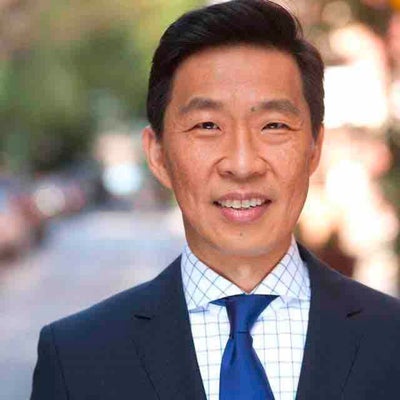An “Asian rhinoplasty” is a variation of traditional rhinoplasty surgery performed on a patient of East Asian descent.
While having a more Caucasian nose was once the goal of many patients of Asian descent, it’s become increasingly common for patients to request a result that preserves their racial identity, according to the authors of “Milestones of Asian Rhinoplasty.”
“It’s a popular misconception that a patient seeking this procedure desires a ‘Caucasian nose,’” says Dr. Jimmy Sung, a board-certified plastic surgeon in New York City. “This fallacy is based on an over-simplistic East-West dichotomy view of aesthetics and failure to recognize the anatomical differences among individual patients."
Dr. Sung underscores that the goal of most Asian patients is no different from that of any other rhinoplasty patient: “to bring their nasal form into balance with their facial features. By achieving the patient’s desire for harmony, the beauty of their individuality and diversity is naturally preserved,” he explains.
While rhinoplasty procedures on Caucasian noses typically involve a reduction of structures, often to soften a dorsal hump or refine the nasal tip, Asian nose jobs are, in essence, nasal augmentation: surgeons usually augment the bridge, lengthen the nose and create more tip definition.
As with other ethnic rhinoplasty procedures, common physical characteristics can influence how this plastic surgery is performed. But, surgeons should be careful not to over-generalize across the board.
According to Dr. Sung, it's inaccurate to categorize all East Asian noses as having low bridges, thick skin, and bulbous nasal tips. Patients from certain regions may possess these qualities, but those from other parts of East Asia may have a nasal hump, thinner skin, and more sculpted nasal tips.
Surgical techniques include cartilage grafts, typically from the rib or back of an ear, reinforcing the bridge and creating more tip definition. "With a Caucasian nose, the septum is usually the common place you harvest cartilage," explains Dr. Sung. "But the East Asian population usually doesn't have a lot of septal tissue, which is why the nose is short to begin with, so there is usually not enough to work with." In the U.S., fresh, frozen rib cartilage (such as those provided by non-profit organizations such as MTF Biologics) can also be used instead of the patient's rib cartilage, sparing an extra incision on the chest. Long-term studies have found fresh frozen donor rib grafts safe, stable, and sound long-term outcomes. Unlike the irradiated rib grafts used elsewhere in the world, which are prone to resorption, fresh, frozen rib cartilage incorporates with the patient's tissue over time for long-lasting results, Dr. Sung explains.
Beyond nasal augmentation, patients with wide nostrils may also have an alarplasty, to narrow the base of the nose. Not every East Asian patient wants or requires an alarplasty, however, and misdiagnosing this as a need can create "a very manufactured-looking nose" with unnecessary scarring, says Dr. Sung.
The thickness of the nasal skin also plays a role in the treatment plan. Many patients of northern Chinese, Korean, and Japanese descent tend to have thinner skin, says Dr. Sung, while patients from other parts of Asia may have a thicker skin envelope that blunts or obscures the nasal tip, requiring surgeons to do more extensive work with cartilage grafts and remove some fatty tissue at the end.
Rhinoplasty is widely considered the most technically demanding form of aesthetic plastic surgery, and the outcome usually takes years to reveal. Furthermore, not all providers have mastered the specialized techniques and have the skill to provide a natural-looking result that balances the facial features while respecting each patient's aesthetic goals and ethnic identity. This makes it especially important to find a surgeon (ideally a board-certified plastic or facial plastic surgeon) who has decades of experience performing Asian nose jobs on patients who look similar to you, with before and after photos showing the type of results you're after.
"Each ethnicity has its cultural ideas of beauty that must be appreciated and enhanced with any procedure that's performed," notes Dr. Jonathan Kulbersh, a board-certified facial plastic surgeon in Charlotte, North Carolina. "If you're interested in ethnic rhinoplasty that respects your cultural identity, take the time to find a professional with experience in this area."
Pros
- An expertly performed rhinoplasty with natural-looking results can enhance the beauty of your nose and create more balanced, harmonious facial features.
- A well-executed Asian rhinoplasty can preserve your ethnic identity while minimizing the traits that bother you.
- Asian rhinoplasty patients may find that their new nose increases their confidence.
- This nose surgery can simultaneously address aesthetic desires and functional issues, like making it easier to breathe.
Cons
- You'll have some idea of your results as soon as your bandages are removed, but it can take one to two years for all of the swelling to resolve so that you can see the final result.
- The hard cast that's worn for the first week after Asian nose surgery can be uncomfortable and make your nose feel clogged.
- This cosmetic surgery is expensive and not covered by insurance.
- If your nose doesn't heal properly or you don't like your results, you may need revision surgery, which can be more difficult and expensive.
- Average Cost:
- $18,695
- Range:
- $9,000 - $29,350
How much your Asian rhinoplasty costs will depend on:
- your surgeon's credentials, level of experience, and reputation
- Their practice location (providers in upscale neighborhoods of major metros usually have to charge more to help cover their overhead)
- The type of anesthesia you have
- The complexity of your procedure, which determines how long it takes
- Whether you have complementary procedures, like V-line chin surgery, at the same time
Purely cosmetic nose jobs are not covered by health insurance. However, if the operation includes a medically necessary procedure like septoplasty, to repair a defect or improve your breathing, a portion of your procedure may be covered by insurance.
The best way to get a personalized cost quote, tailored to your treatment plan, is to consult with at least one qualified plastic or facial plastic surgeon.
RealSelf Tip: If you're not ready to commit to the cost and permanence of a surgical procedure, you may want to consider a nonsurgical "liquid rhinoplasty," which uses dermal fillers to temporarily change the shape and appearance of the nose.
The Asian rhinoplasty photos in our gallery have been shared by the surgeon who performed the procedure, with the patient's consent.
This procedure typically takes two to three hours, depending on its complexity.
Before it starts, you'll be given either general anesthesia or local anesthesia with sedation.
Your facial features, aesthetic goals, and surgeon's preferred technique will determine your treatment plan.
Your procedure may involve:
- Building up the nasal bridge with a cartilage graft, to elevate a low-set or flat dorsum.
- Making the nose longer via cartilage grafting.
- Narrowing wide or flaring nostrils via alarplasty. Incisions are made at the crease between your nostril and cheek, and a thin wedge of soft tissue is removed.
- Refining the tip of the nose with cartilage grafting and/or the removal of excess fatty tissue under the skin. (Note that if your skin is thick, there may be a limit to the amount of tip refinement your surgeon can achieve.)
- Repairing a deviated septum, to improve breathing.
As we mentioned earlier, cartilage grafts are commonly used to build up the nasal architecture, so that it's stronger and more defined. If you need a cartilage graft, your surgeon may opt for an open rhinoplasty technique.
Open rhinoplasty involves lifting the skin off the nose to allow better visibility and access to the inner nasal structure, which some surgeons say contributes to a better result. It requires an incision across the columella (the narrow strip of tissue between the nostrils), so there can be a small visible scar. If the possibility of a scar concerns you, ask your provider if a closed rhinoplasty procedure would work in your case.
RealSelf Tip: Some surgeons use nasal implants for nose reshaping, such as creating a higher bridge or defining the nasal tip. Dr. Douglas Henstrom, a board-certified facial plastic surgeon in Draper, Utah, cautions that "silicone implants often look unnatural and have a high risk of future complications because they do not become incorporated into the tissue of the nose."
While infections and extrusion can happen, Dr. Sung stresses that patients with nasal implants shouldn't panic or rush to revision. "That's unnecessary," he says. While he doesn't use nasal implants in practice, he advises those who have them to leave them alone if they're happy with their results and the implants aren't causing problems.
Asian rhinoplasty is a safe, effective procedure when it's performed by a board-certified facial plastic surgeon or plastic surgeon, especially one who specializes in ethnic rhinoplasty procedures.
Common side effects include minor bleeding, bruising, and swelling.
Rarer complications of this cosmetic procedure include:
- A severe nosebleed (epistaxis) that requires immediate medical care
- Infection
- Nasal obstruction and difficulty breathing
- Septal perforation (a tear in the lining of the nasal septum)
It's also possible to have a poor cosmetic result, such as a visible scar or asymmetry, that may require revision rhinoplasty surgery.
Your surgeon should discuss all of these potential risks during your initial consultation.
All rhinoplasty procedures come with up to two weeks of downtime afterward. It's possible that you could be feeling (and looking) well enough to go back to work and resume light activity within 10 days.
Related: 8 Rhinoplasty Recovery Rules You Should Always Follow After Surgery
Your surgeon will provide detailed aftercare instructions, but here's what you can expect, generally speaking:
- After surgery, you'll have a splint on your nose for about one week, possibly followed by tape the second week.
- If rib or ear cartilage is removed, you may have tenderness at the incision site.
- Expect bruising and significant swelling around the nose during the first week. The severity will depend on your individual anatomy and the extensiveness of your surgery (like, for instance, whether any nasal bones were broken).
- During this time, you'll also feel very congested and may have some bleeding.
- If you wear glasses, be aware that many surgeons won't allow patients to wear them for a month to avoid putting pressure on the healing bridge.
- Most of the swelling should subside in the first three months, but it can take up to two years for it to fully resolve for patients with thick skin.
Related: The Ultra-Precise Nose Job Technique That Results in Less Bruising and Faster Healing


